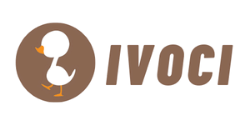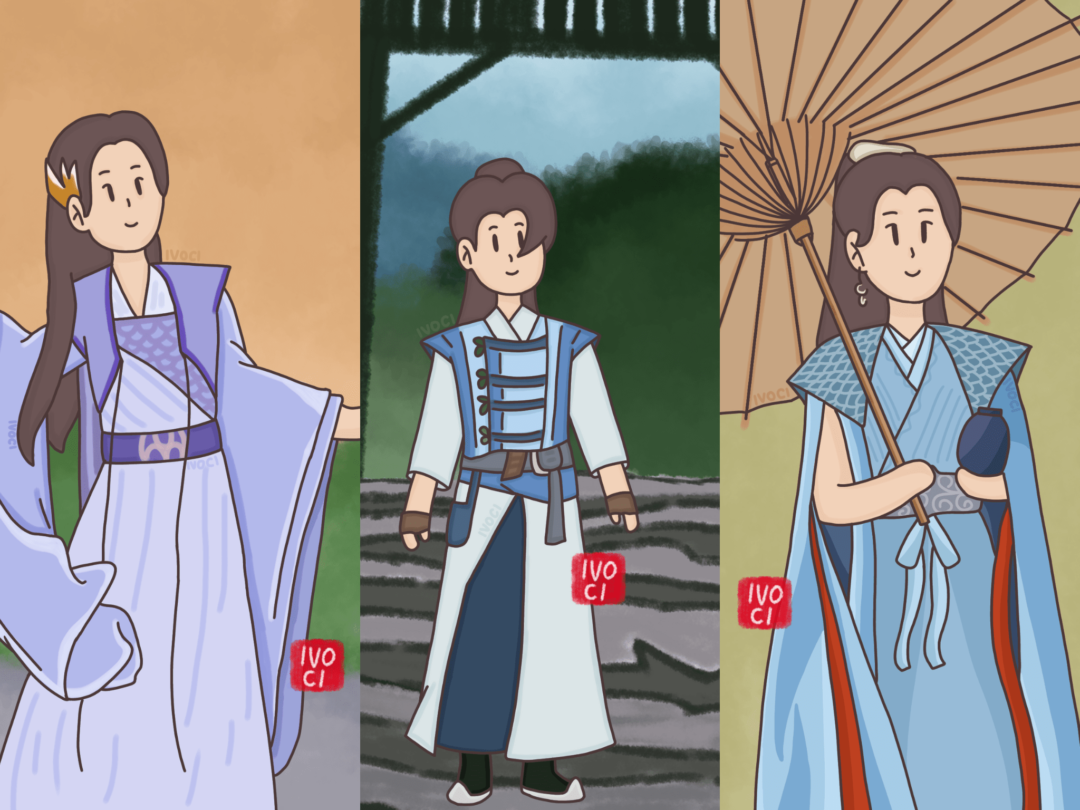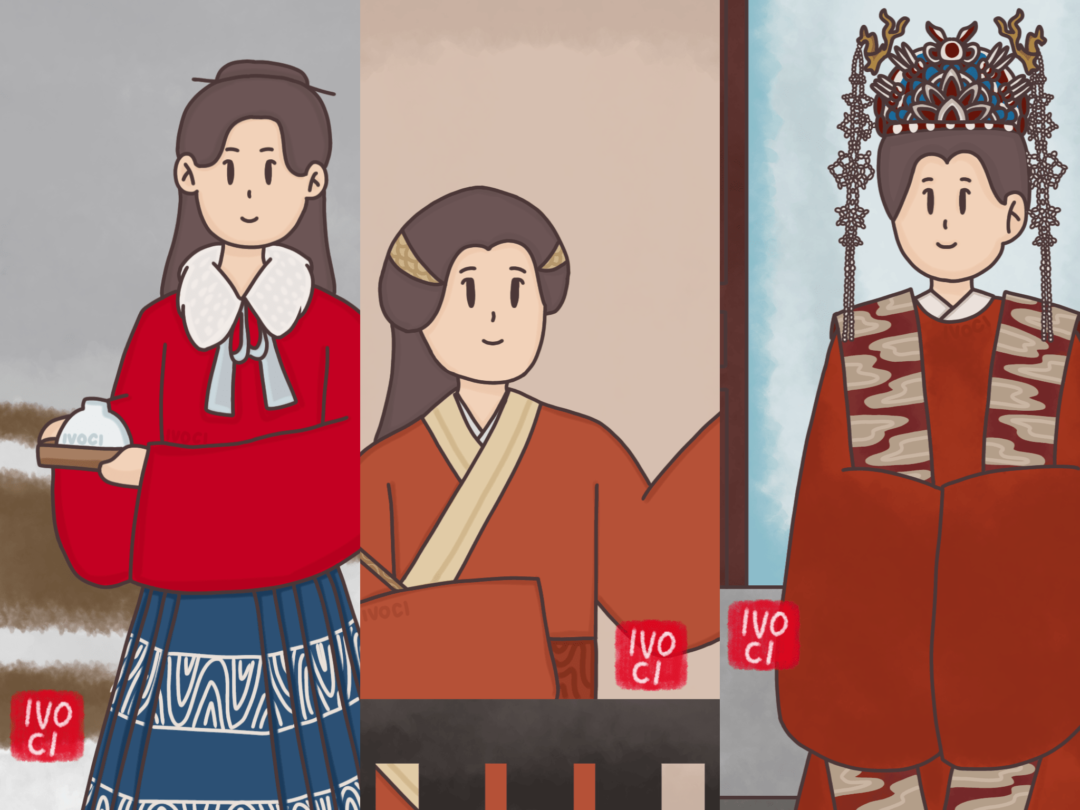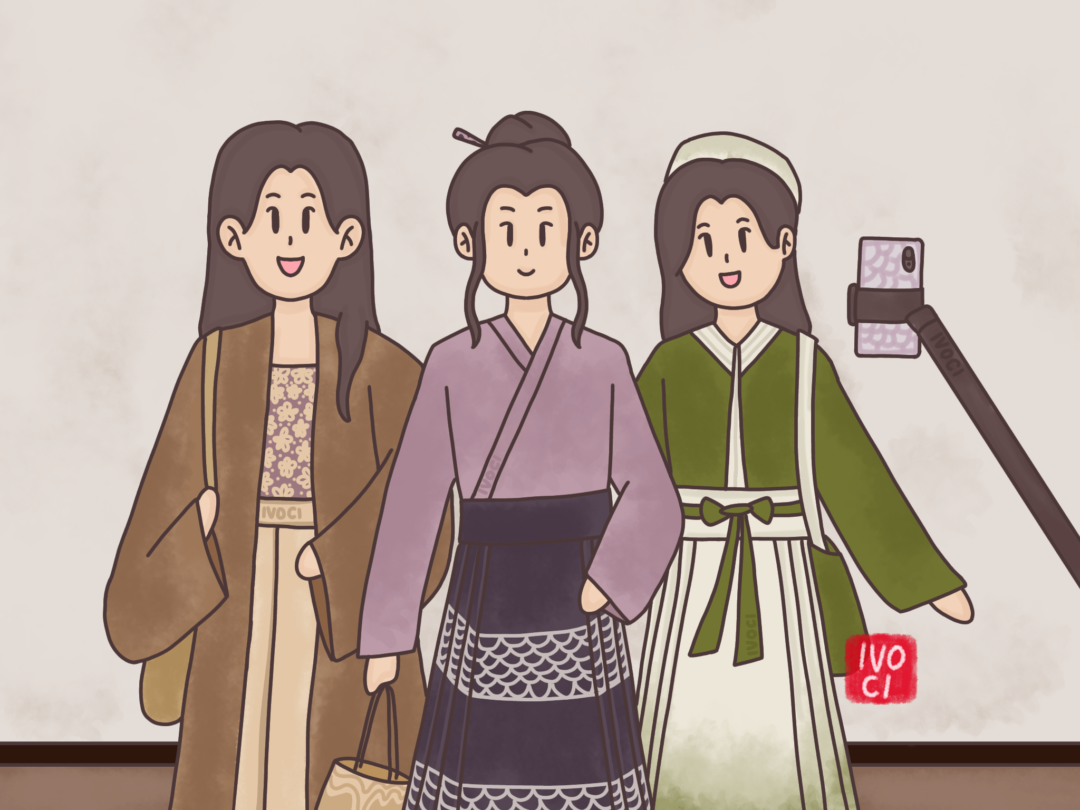Do you often see these clothes in many historical Chinese dramas?
These clothes are called hanfu (Chinese: 汉服 ; pinyin: hàn fú).
Hanfu is traditional Han Chinese clothing that has been around for more than 4,000 years.
With the passage and change of dynasties in China, hanfu also changed and developed.
Hanfu has existed from the Xia dynasty to the (before) Qing dynasty, including until now.
Specifically, hanfu from the Xia dynasty to the (before) Qing dynasty is often called historical hanfu or hanfu by dynasty, because they are based on history and have concrete evidence, such as paintings.
There are also modified hanfu / contemporary hanfu, which we usually see in wuxia, xianxia, or xuanhuan dramas.
With the hanfu movement, hanfu is gaining popularity again and we can use hanfu in our daily life in today’s modern era.
These are clothes that have hanfu elements in them, often called hanyuansu (Chinese: 汉元素 ; pinyin: hàn yuán sù).
a. Historical hanfu / Hanfu by dynasty
Chinese history is very long, here is a list of dynasties and history in China.
- Ancient China
- Xia dynasty (夏朝) 2100 – 1600 BC
- Shang dynasty (商朝) 1600 – 1100 BC
- Zhou dynasty (周朝)
- Western Zhou (西周) 1100-771 BC
- Eastern Zhou (东周) 770 – 256 BC
- Spring and Autumn period (春秋) 770 – 476 BC
- Warring States period (战国时代) 476 – 221 BC
- Qin dynasty (秦朝) 221 – 206 BC
- Han dynasty (汉朝) 206 BC – 220
- Western Han (西汉) 206 BC – 24
- Eastern Han (东汉) 25 – 220
- Three Kingdoms (三国) 220–280
- Cao Wei (曹魏) 220–265
- Shu Han (蜀汉) 221–263
- Eastern Wu (东吴) 222–280
- Jin dynasty (晋朝) 265 – 420
- Western Jin (西晋) 265 – 316
- Eastern Jin (东晋) 317 – 420
- Sixteen Kingdoms (十六国 / 五胡十六国) 304 – 439
- Han Zhao (汉赵) 304–329
- Cheng Han (成汉) 304–347
- Later Zhao (后赵) 319–351
- Former Liang (前凉) 320–376
- Former Yan (前燕) 337–370
- Former Qin (前秦) 351–394
- Later Yan (后燕) 384–409
- Later Qin (后秦) 384–417
- Western Qin (西秦) 385–400, 409–431
- Later Liang (后凉) 386–403
- Southern Liang (南凉) 397–414
- Northern Liang (北凉) 397–439
- Southern Yan (南燕) 398–410
- Western Liang (西凉) 400–421
- Hu Xia (胡夏) 407–431
- Northern Yan (北燕) 407–436
- Northern and Southern dynasties (南北朝) 420 – 589
- Northern dynasties (北朝) 386–581
- Northern Wei (北魏) 386–535
- Eastern Wei (东魏) 534–550
- Western Wei (西魏) 535–557
- Northern Qi (北齐) 550–577
- Northern Zhou (北周) 557–581
- Southern dynasties (南朝) 420–589
- Liu Song (刘宋) 420–479
- Southern Qi (南齐) 479–502
- Liang dynasty (梁朝) 502–557
- Chen dynasty (陈朝) 557–589
- Sui dynasty (隋朝) 581–618
- Tang dynasty (唐朝) 618–690, 705–907
- Wu Zhou (武周) 690–705
- Huang Qi (黄齐) 881–884
- Five Dynasties and Ten Kingdoms (五代十国) 907–979
- Five Dynasties (五代) 907–960
- Later Liang (后梁) 907–923
- Later Tang (后唐) 923–937
- Later Jin (后晋) 936–947
- Later Han (后汉) 947–951
- Later Zhou (后周) 951–960
- Ten Kingdoms (十国) 907–979
- Former Shu (前蜀) 907–925
- Yang Wu (杨吴) 907–937
- Ma Chu (马楚) 907–951
- Wuyue (吴越) 907–978
- Min (闽) 909–945 & Yin (殷) 943–945
- Southern Han (南汉) 917–971
- Jingnan (荆南) 924–963
- Later Shu (后蜀) 934–965
- Southern Tang (南唐) 937–976
- Northern Han (北汉) 951–979
- Liao dynasty (辽朝) 916–1125
- Northern Liao (北辽) 1122–1123
- Western Liao (西辽) 1124–1218
- Dongdan (东丹) 926–952
- Song dynasty (宋朝) 960–1279
- Northern Song (北宋) 960 – 1127
- Southern Song (南宋) 1127 – 1279
- Western Xia (西夏) 1038–1227
- Jin dynasty (金朝) 1115–1234
- Yuan dynasty (元朝) 1271–1368
- Ming dynasty (明朝) 1368–1644
- Qing dynasty (清朝) 1636–1912
- Republic of China (中华民国) 1912 – 1949
- People’s Republic of China (中华人民共和国) 1949 – Now
Each dynasty produced its distinctive style of dress, reflecting the socio-cultural environment of the time.
Hanfu has changed and evolved with the fashion of the days since its beginnings which are generally assumed to be in the Shang dynasty.
Many factors contributed to ancient Chinese clothing, including beliefs, religion, wars, and the emperor’s personal preferences.
b. Hanfu movement
The hanfu movement is an ongoing social movement that aims to popularize hanfu and integrate traditional Chinese elements into modern clothing designs, as a way to promote traditional Chinese culture.
Entering the 21st century, hanfu has become a lucrative fashion trend and business sector.
A study conducted by the Forward Industry Research Institute (a Chinese research institute) shows that in 2020, the number of hanfu fans in China reached 5.163 million, creating a market size equivalent to 6.36 billion yuan (US$980 million), a proportional increase by more than 40% compared to the previous year.
Meanwhile, it is estimated that in the coming years, the number of hanfu fans will continue to grow.
c. Modern Hanfu
On March 8, 2021, Vogue magazine published an article on modern hanfu defining it as “a type of dress from any era when Han China ruled” and reporting that styles based on the Tang, Song, and Ming dynasties were the most popular.
Modern Hanfu can be classified into three categories:
1. Historical / ancient hanfu, is a reproduction of the historical style of hanfu worn by the Chinese people before the early Qing dynasty. These reproductions are made strictly in the style depicted in ancient paintings, murals, and/or archaeological finds.
2. Improved hanfu (also known as modern hanfu, new hanfu, and restored hanfu) which refers to hanfu developed based on the historical style of hanfu, and largely retains the ancient style (it can still be classified into the category of historical hanfu which exist, such as ruqun and beizi), but with modern aesthetics and technology introduced into the design.
3. Hanyuansu (Chinese: 汉元素 ; pinyin: hàn yuán sù) or Han element clothing, refers to modern / everyday clothing with hanfu style features and/or elements in its design, but cannot be classified into historical / ancient hanfu category.
Characteristics and design
Most modern hanfu is based on statues, paintings, art objects, historical records, and historical clothing.
Modern hanfu can combine the characteristics of ancient hanfu (e.g. adhering to the traditional two-dimensional cut rather than the three-dimensional cut) and modern society’s aesthetic and technological standards in terms of style, clothing color, clothing construction, and materials.
Modern hanfu is also not limited by the use of color and decoration design regulations, for example, modern hanfu allows the use of dragons and the color yellow which had been banned in the ancient dynasties.
Some people even mix different hanfu clothes from different dynasties.
Modern hanfu is also turning into a style that can be worn every day, and this style is combined with western clothing or even clothing from other cultures.
For example, the recent emergence of the Christmas-themed hanfu trend (which occurs especially during the Christmas season) on social media and online stores incorporates hanfu with Christmas elements and Christmas color schemes.
Another trend is the incorporation of lace (western style) elements into hanfu. However, these designs are not considered authentic hanfu but are considered clothing with Han (or hanyuansu) elements.
Some modern hanfu designs are influenced by kawaii culture and are a targeted choice for young women who want a cute look.




Leave a Reply